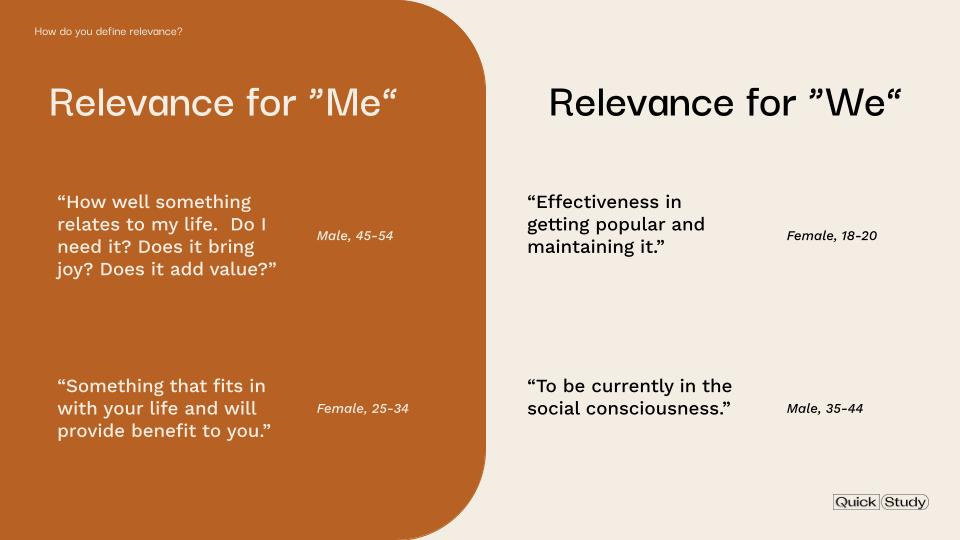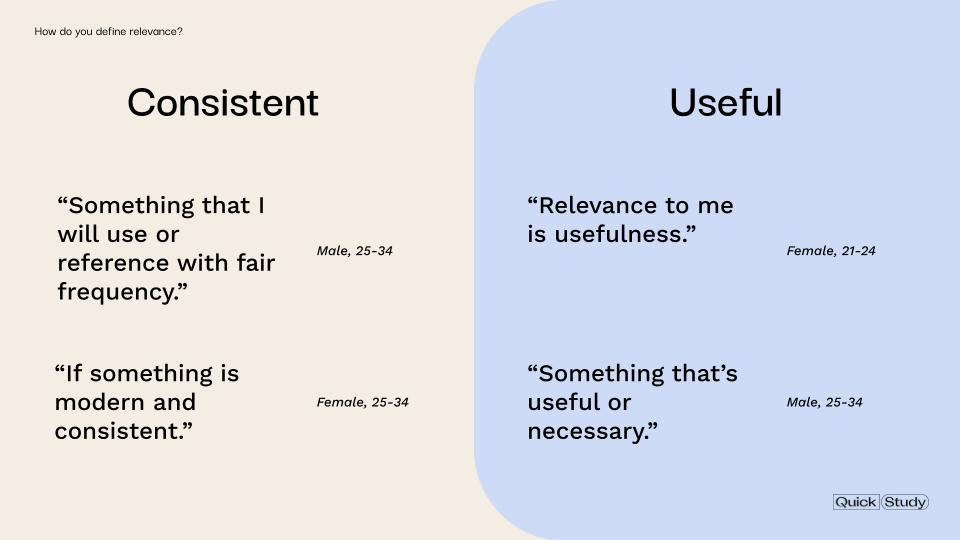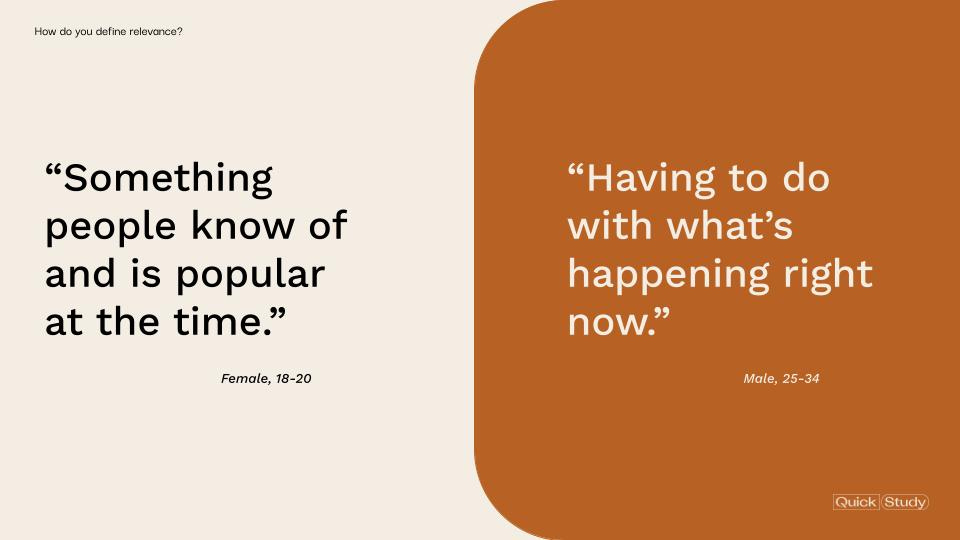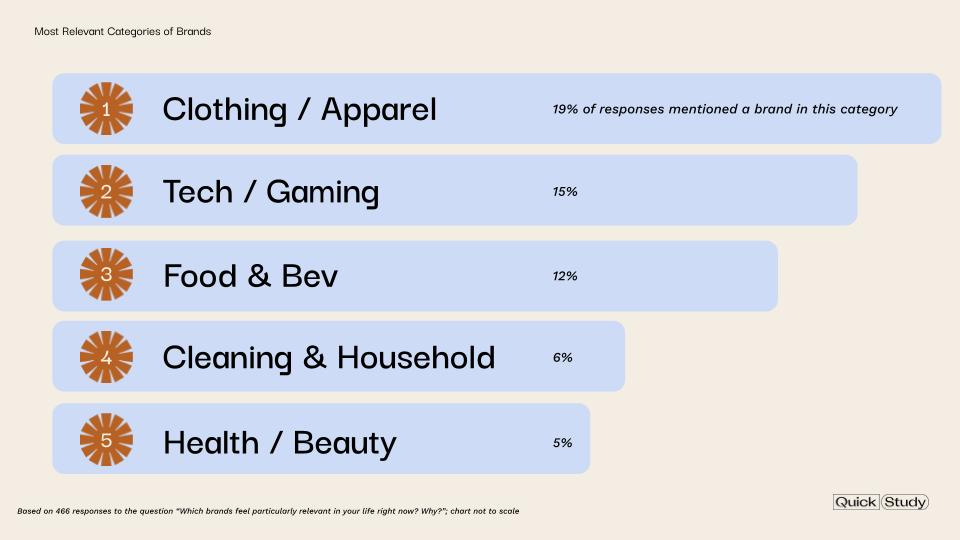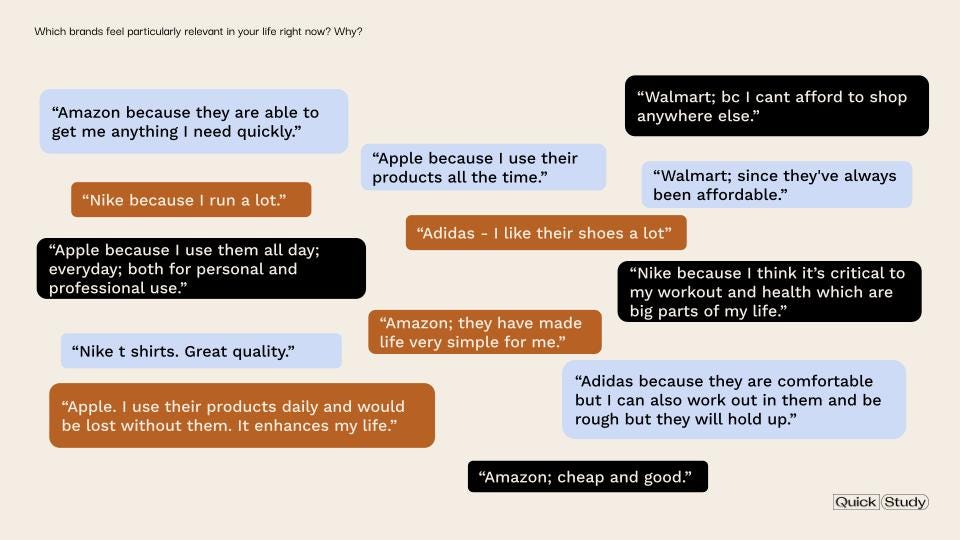Defining Relevance: Part 1
We asked over 450 people to define the word & tell us what factors make brands relevant to them.
Hi. Hey. Hello. This is the eleventh edition of The Other 90, a blog about strategy from Quick Study. If this is your first time, welcome! Feel free to check out the archive. You can also view this post on our website.
Let’s start here:
The idea of “relevance” can at times be quite nebulous, making it both a powerful idea and an easy out. It’s become particularly buzzy in advertising, the type of thing we’re all supposed to just “get” in order to do our jobs well. Because of that expectation, we all claim to know relevance when we see it. But how do other people see it? What role do people see relevance playing in their relationship with brands? And what factors give a brand a better shot at being relevant?
A few weeks ago, Quick Study asked consumers those questions. In a series of two surveys using the tool OnePulse, we asked nearly 500 Americans to define relevance, name brands they feel are relevant in their life right now, and pick the factors that are most important to them when it comes to determining a brand’s relevance. Our results gave us five key learnings that will help shape how we think moving forward, and may be useful to you, too.
The five key learnings are:
Relevance is about me, not we.
Being cool or of-the-now doesn’t necessarily make you relevant.
Most brands aren’t top of mind to everyday consumers.
The actual product is still the most important contributing factor to a brand’s ongoing relevance.
Top funnel relevance comes from a combination of factors, not just one.
Today, in part one of our Study Guide on Defining Relevance, we’ll review learnings 1-3. A second post diving into learnings 4 and 5 will follow in the coming days.
Learning #1: Relevance is about me, not we.
As part of our survey, we gave 462 respondents the chance to define relevance in their own terms.1 We then evaluated the responses for common words, themes, and trends. When defining relevance, 24% of respondents used personal words like I, me, or you in their answers, while only 17% used words that tied relevance to the broader community like mass appeal, culture, or popular.
At Quick Study we often speak about the need to stop viewing the world of consumers through the lens of a monoculture but instead as thousands of subcultures that consumers engage with at varying depths and degrees. The knowledge that a personal connection needs to be forged for a brand to feel relevant, rather than just relying on mass relevance, is important framing.
We also saw 11% of respondents tie their definitions to the frequency/consistency at which they personally engaged with a brand, or approach the definition from the perspective of how useful/convenient a brand is to them. While not an incredible number, these themes stood out in light of the personal relevance discussed above: time spent in front of my face and/or showing me functionality that I will value are both ways a brand can make itself feel more personal (if the message is right).
The theme of frequency popped up enough here that we added it as part of our questions from part 2, so stay tuned for that to see how important it truly is to creating relevance (spoiler alert: more than you may think, but less than other factors).
One last thought on this learning: A more “me” focused definition of relevance seems to support the shift toward “Recommendation Media” as outlined in this piece by Anchor co-founder Michael Mignano. “Social media has also proven to simply not be that efficient in terms of matching high quality content with a relevant audience,” he wrote. “Just because people can easily distribute content to their friends or friends of friends doesn’t mean that that content will be interesting or relevant to the consumer."
Seeking broad social media virality is monoculture thinking. To make an impact with consumers we need to think much more in terms of value for one than value for all, because in a world of recommendation media the consumer has the power to decide what’s relevant or not.
Learning #2: Being cool or of-the-now doesn’t necessarily make you relevant.
In fact, a fine line between virality and relatability emerged as we evaluated the survey responses that further proves the importance of the personal. When asked to define relevance, only 11% of respondents used terms such as well-known, popular, or cool to describe relevance, and 10% focused their definition of relevance on feeling current, “of-the-now”, and/or “in-the-moment”.
The fact that so many people do not connect these terms with relevance is what matters here. This shows that consumers have a nuanced understanding of what relevance is not - in particular that a brand doesn’t need to be on the cutting edge to be relevant in their lives. Once again, the me over the we - people can separate the “Trendy” from the “Relevant to me” and see more value in the latter.
In the past I’ve written about how I created the Science of Hype by focusing on the collision of novelty, scarcity, and influence to create a perfect storm of virality around a product or brand. As many have noted recently, we seem to have hit peak cultural hype, and when everything is hyped, what even is hype anymore?
Now we’re seeing that about the same amount of respondents used usefulness and convenience to describe relevance as they did popular and cool. Is it a result of inflation concerns? Oversaturation of “hype” storytelling? Regardless, it seems that hype for hype’s sake, while never the perfect solution for long-term relevance, is certainly a diminished tactic today.
Learning #3: Most brands aren’t top-of-mind to everyday consumers.
There are many stats that point to the general ineffectiveness of advertising if it doesn’t feel relevant. For example, according to GlobalWebIndex, only 11% of Americans feel represented in the advertising they see. With close to $300 billion spent on advertising in the US alone in 2021, that seems like a pretty bad success rate!
To see if these types of stats hold water, we gave 466 respondents to our survey the chance to name any brands that feel particularly relevant in their lives today.2 While 70% named at least one brand in their response, 30% couldn’t name one brand they felt matched that description or specifically said they don’t feel like any brand is relevant to them. It’s not as bad a stat as the 11% from above, but it’s still pretty bad that so many consumers don’t feel like any brands have built a relevant connection with them.
One other initial finding was a theme of cost consciousness. 9% of respondents to this question named brands specifically for their low costs during a time of economic difficulty. (Cost and its current relation to relevance is also a major component of learning #4, which we’ll break down in the second part of our research.)
After looking at the results of the brands that were mentioned, we organized them by category to see where consumers are finding relevance right now. Clothing brands came first, mentioned by 19% of the respondents, followed by tech & gaming brands at 15%, food & beverage brands at 12%, cleaning & household products at 6%, and health/beauty brands at 5%.
Returning to the hype train for a moment, I’d be remiss not to point out that only 5 of the 466 respondents named a luxury brand (1%). All 5 named Gucci.
But what were the top brands mentioned? The top 5 are brands that probably don’t surprise, but they are a microcosm of what we’ve discussed today: frequency of use, convenient, economically friendly, etc.
Nike - mentioned by 10% of respondents
Apple - 6%
Amazon - 6%
Walmart - 4%
Adidas - 3%
For the purpose of our research around defining relevance, we didn’t go any deeper on the question of specific relevant brands. If you’re particularly interested in dissecting that topic, feel free to check out Prophet’s Brand Relevance Index and methodology.
So now we have a better sense of how people look at relevance, and have started to see some trends emerge when it comes to what factors make up relevance. We’ve learned that relevance is a personal experience, and that consumers tend to separate the “cool” from the relevant in their lives.
We wanted to dig deeper on some of these learnings, so we followed up with 200 of our respondents to have them rank the most important elements that make up relevance. We wanted to see if who is telling the story matters more than the when or where, as well as see how much cost and quality play a role in a brand’s overall relevance (spoiler alert: they do, but for some demographics more than others). Those results to follow in part two!
The Other 90 is written by Rob Engelsman, a former baby model and now Co-Founder & Strategy Partner at Quick Study. You can find him on Twitter, Instagram, & LinkedIn. You can also email him at rob@quick.study.
“How do you define relevance?” - 462 responses considered in this analysis
“Which brands feel particularly relevant in your life right now? Why?” - 466 responses considered in this analysis


